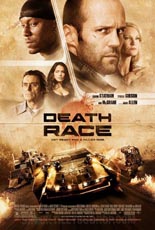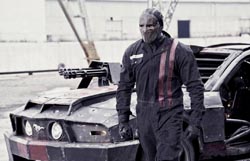
 Ib Melchior’s short story “The Racer” — the source material for 1975’s Roger Corman-produced cult classic Death Race 2000 — doesn’t even receive credit in the 2008 remake Death Race until the very end. No big deal — it bears little resemblance to the story, anyway.
Ib Melchior’s short story “The Racer” — the source material for 1975’s Roger Corman-produced cult classic Death Race 2000 — doesn’t even receive credit in the 2008 remake Death Race until the very end. No big deal — it bears little resemblance to the story, anyway.
That 10-pager — I first encountered it in the Forrest J. Ackerman-edited anthology Reel Future — is little more than a quick morality tale, about Hank and Willie, two guys with a car equipped with bull’s horns on the front, competing in a cross-country race in which scores are obtained by mowing down pedestrians. They’re skilled at making kills until one of them starts imagining the face of his daughter on all of their targets, and decries his participation.
 For Corman, screenwriter Charles B. Griffith (The Little Shop of Horrors) and director Paul Bartel (Eating Raoul) just took that core idea of the race and amped it up with a bevy of colorful characters with crazy names — Hank or Willie simply wouldn’t do — like Frankenstein, Machine Gun Joe, Calamity Jane, Matilda the Hun and Nero the Hero. They also kept the bull’s horns.
For Corman, screenwriter Charles B. Griffith (The Little Shop of Horrors) and director Paul Bartel (Eating Raoul) just took that core idea of the race and amped it up with a bevy of colorful characters with crazy names — Hank or Willie simply wouldn’t do — like Frankenstein, Machine Gun Joe, Calamity Jane, Matilda the Hun and Nero the Hero. They also kept the bull’s horns.
For Hollywood’s big-budget remake and these PC times, however, mowing down innocent people for sport won’t do, so writer/director Paul W.S. Anderson (Resident Evil) makes his competition internal, in an enclosed track on a prison island. The drivers are hardened criminals; five victories and freedom is granted, according to icy warden Joan Allen (Face/Off).
In the ’75 film, former Kung Fu master David Carradine was the star, a heavily scarred racer named Frankenstein who hid his face behind a mask for much of the film. In this ’08 model, Frankenstein is the race’s superstar, but it doesn’t matter much who’s behind the mask. When the first Frank dies in an earlier Death Race, the warden asks new felon Jensen Ames (original Transporter Jason Statham) to take the name and get behind the wheel. Of course, Statham looking like Statham, he only has to wear the mask in a couple of scenes because no one can see through the windows of his souped-up Ford Mustang.
The one element from Melchior’s tale that the new film makes use of is the idea of the daughter. Here, she’s a newborn, but she drives Ames’ conscience. It’s a little out of place and feels tacked on at the end, but doesn’t detract from a stupidly enjoyable hour and a half. Bartel’s film was an all-out satire; Anderson’s is an all-out actioner. Melchior’s “The Racer” lay not quite committed to either. —Rod Lott
